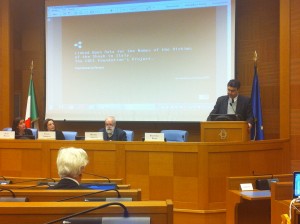FEATURES Open Data for Shoah Memory
The Center of Jewish Contemporary Documentation – CDEC (the non-profit Institute for Italian Jewish History and Culture) begins the new year with a great and extraordinary project called “Linked Open Data for the Names of the Victims of the Shoah in Italy”: in this manner, all the names of Italian victims of the Shoah collected by the historian Liliana Picciotto will be available online with information about their identities and linked to databases of other institutions. This project was made possible by Laura Brazzo of CDEC in collaboration with the company “regesta.exe”. Last week CDEC organized a workshop called “Linked Open Data & The Jewish Cultural Heritage” at the Chamber of Deputies in Rome to introduce it and find new ideas in the field of technology.
“Today, thanks to new Semantic Web related technologies – reads the CDEC website – people and institutions working on a specific subject can cooperate in a decentralized and synergistic way, interconnecting their resources which would otherwise remain ‘isolated’ on the web. Institutions such as archives, libraries and museums have quickly seen the strength and potentialities inherent to, and stemming from, these technologies. The number of projects aimed at the opening and the sharing of information in the cultural field are the clearest demonstration of the enrichment of learning opportunities coming from the Semantic Web.
The workshop, Linked Open Data & the Jewish Cultural Heritage, aims for discussion, starting from some key-concepts of the Semantic Web: how the opportunities offered by the new technologies can improve our knowledge of Jewish history and expand the resources available on the web concerning this topic.”
The event was made possible thanks to the patronage of the Chamber of Deputies, the Union of Italian Jewish Communities, W3C Italy, the Ministry of Heritage, Culture and Tourism, the Foundation of the Museum of the Holocaust and the Coordinating Committee for the Celebration of the Memory of the Shoah with the support of friends of the Foundation CDEC.
“Thanks to new technologies applied to archives and cultural institutions,” explained the director of the CDEC Michele Sarfatti, “research that we carried out yesterday in several weeks, today is possible with just one click: now everything can be explored much deeper”. Sarfatti read also a message from the President of the Chamber of Deputies, Laura Boldrini: “I want to show my sincere appreciation for the project which will be presented today. The purpose of all of this is to enhance the historical and cultural Jewish Italian experience to as many users as possible. Greater knowledge of the Holocaust makes a valuable service to our Democracy, especially after the last few days in which the non-respect of differences resulted in senseless and violent actions”.
Emanuele Fiano of the Chamber of Deputies added: “Every day I receive reports of falsification or misinterpretation of history. It is precisely for this reason that I believe that the government should not stop questioning the teaching of the Shoah. The work of the CDEC on the Shoah should not be seen as the work of archaeologists but the contemporary construction of knowledge.”
“Before the introduction of digitization and LOD (linked open data) work was very different,” evoked Liliana Picciotto, the historic pioneer of the CDEC and a member of the UCEI council. “Where did we start? While in the Seventies when IBM developed the first methods of digital listing, we were just beginning to fill out cards on the more than 9,000 Italian Jews deported by hand. Each line corresponded to a category of information. Then in the Eighties when Olivetti gave us the first model computer we were super excited”.
Laura Brazzo explains the steps for digitization made by the CDEC: “Through the LOD we did an interactive linking to the resources we have via photographic and historical archives. Starting from Liliana Picciotto’s database we created our ontology and each man and woman was given a specific and unique code. In this way our center has become one of the first Italian institutions to apply this methodology. In a week, the database will become available: each user can reconstruct the identity of every Italian Jew deported, learning the date of their arrest, as well as the names of the those who left on the same convoy.
Silvia Mazzini, of”regeste.exe”, then explains how a specific CDEC ontology was created: “We used the language known as Owl and studied the existing ontologies. Ontology is the comprehensive description of a particular domain of interest, then a prerequisite for LOD. Our aim was and is that the data be shared as much as possible.”
The workshop was attendend, among others, by Oreste Signore, W3C Italia, Andrea Marchetti, CNR-IIT, Marco D’Orta, Chamber of Deputies, Kai Eckert, University of Mannheim, Diego Camarda, regeste.exe, Dov Winer, Hebrew University, Yeal Gherman, Yad Vashem, Adina Molad, Yad Vashem, Chiara Veninata, MIBACT, Giovanni Bruno, regesta.exe, Micaela Procaccia, MIBACT; Maurizio Vivarelli (Turin University), Giovanni Maria Flick honorary president Fondazione Museo della Shoah di Roma.

